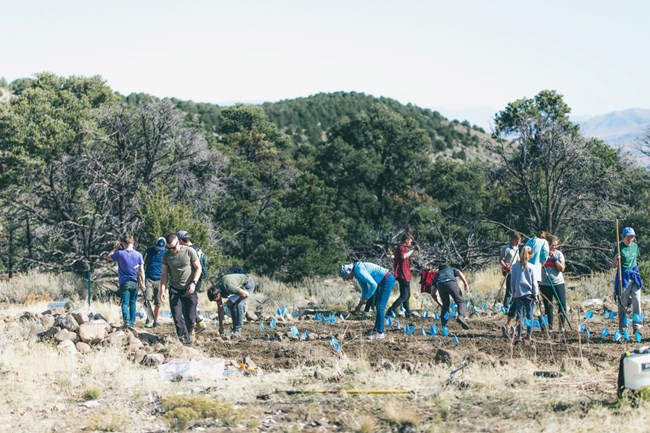Part of a series of articles titled The Midden - Great Basin National Park: Vol. 21, No. 2, Winter 2021.
Article
New Technologies to Help Win the War against Cheatgrass

NPS
The sagebrush ecosystem is considered one of the most imperiled habitats in the United States. At one time, it covered over 150 million acres, but since European settlement, it has shrunk to only 56% of its historic range due to impacts from altered fire regimes, invasive species, conversion to conifer woodlands, and various human disturbances.
Research conducted at Great Basin National Park by graduate student Tyson Terry and others with Brigham Young University and the National Park Service evaluated new seeding technologies to help restore lost sagebrush habitat. Their work was focused on restoring areas that had been invaded by the exotic annual weed, cheatgrass (Bromus tectorum).
Seeding efforts in cheatgrass invaded areas typically fail due to high competition for limited resources. The use of soil-active herbicides is commonly needed to control cheatgrass prior to seeding. However, when seeding is performed concurrently with herbicide application, practitioners struggle with applying herbicide at rates sufficient to achieve weed control without damaging the seeded species.

NPS
Figure 2. Illustration of a proposed technique to remove invasive annual grasses and seed desired species at the same time by A) spraying the site with a premergent herbicide, B) removing the herbicide within a deep furrow, which is planted with seed and C) provides a microsite for the seeds to grow while the herbicide controls invasive weeds in-between the furrows (Taken from Terry et al. In 2021a).

Photo by Tyson Terry
These innovative technologies have the potential to provide land managers with the tools they need to reclaim areas invaded by exotic annual grasses. Improved restoration success in exotic annual grass invaded sites will result in many benefits, including lower firefighting costs, improved forage production for livestock, increased recreational activities, and enlarged habitat for wildlife.
Citations:
Terry, J.T., M.D. Madsen, R.A. Gill, V.J. Anderson, and S.B. St. Clair. 2021a. Selective herbicide control: using furrows and carbon seed coatings to establish a native bunchgrass while reducing cheatgrass cover. Restoration Ecology: Published ahead of press. https://onlinelibrary.wiley.com/doi/ abs/10.1111/rec.13351
Terry, J.T., M.D. Madsen, R.A. Gill, V.J. Anderson, and S.B. St. Clair. 2021b. Herbicide effects on the establishment of a native bunchgrass in annual grass invaded areas: indaziflam versus imazapic. Ecological Solutions and Evidence: 2021;2:e12049. https://doi.org/10.1002/2688- 8319.12049
Last updated: February 6, 2024
